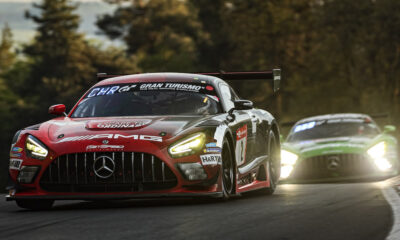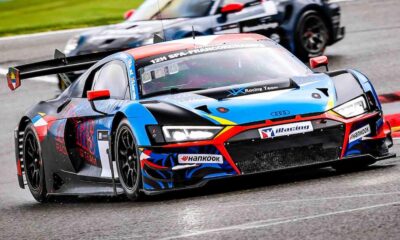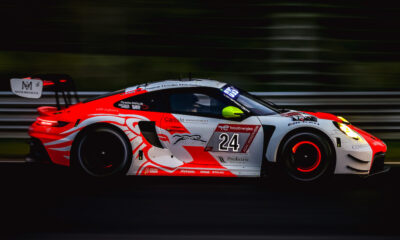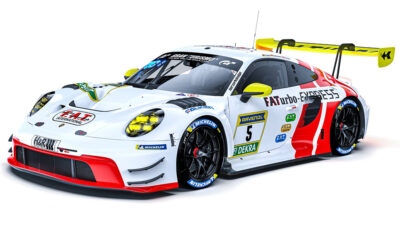
Photo: Ferrari
The first two Intercontinental GT Challenge powered by Pirelli rounds of the 2023 season will not permit new or updated GT3 cars, with SRO Motorsports Group set to utilize its current Balance of Performance tables for the two enduros.
SRO founder and CEO Stephane Ratel confirmed that the Ferrari 296 GT3 and new Porsche 911 GT3 R, plus Lamborghini’s Huracan GT3 EVO2, will not be eligible for either the Liqui-Moly Bathurst 12 Hour or Kyalami 9 Hour because the cars will have not completed SRO’s Balance of Performance tests before the races.
The annual BoP test at Paul Ricard is scheduled for early March, where Bathurst is set to open the IGTC season on Feb. 3-5, followed by Kyalami on Feb. 23-25.
“Bathurst and Kyalami will run on the 2022 specs and then we’ll jump in from there,” Ratel told Sportscar365.
“I know some people are saying, ‘Why aren’t you as ready as IMSA, which is ready for Daytona?’
“But IMSA is doing their own wind tunnel, engine bench and everything. We use FIA GT3 cars and do the homologation and all of this is done by the FIA.
“By the time it’s done by the FIA, by the time we are communicated the data that we can start doing our own analysis and benchmarking before the official test, we can never be ready for January.”
Ratel said previous attempts of moving the BoP test to February have not worked out due to weather, although he remains open to a potential overhaul in the homologation and validation calendar if GT3 manufacturers and the FIA are on board.
“We’ve done the [BoP test] in February a couple of times,” he said. “We had three difficult years.
“Once it rained the whole time. Once it even snowed, so Claude [Surmont, SRO technical director] said, ‘No we can’t continue like this. We need to do it in March.’
“Maybe that needs to be changed but to change we’d need all of the cars to be homologated by the summer with the FIA doing all of the work and to have the data by September, October.
“We could do the BoP test maybe in November. That would be a complete change but the manufacturers are never ready that early.”
Ferrari, Porsche and Lamborghini, which are all impacted by the decision, accounted for three of the four nominated IGTC manufacturers at last weekend’s Indianapolis 8 Hour presented by AWS.
A total of five manufacturers have been registered this season.
SRO Expecting Teams to Split Freight Between Bathurst, Kyalami
With only a three-week gap between the two IGTC rounds, Ratel said he expects teams to divide their equipment instead of utilizing the same machinery for both rounds, which would be unfeasible unless air-freighted.
“For the moment, many teams can send different cars,” he said. “That’s what we’re telling them.
“You send one to Bathurst and send another container to Kyalami and you avoid the environmentally and financially unfriendly air freight.”
Ratel explained the decision to place Kyalami in late February came down to the start of the European season and the best prospects of having a solid grid in South Africa.
“We always had this in IGTC,” Ratel said of a short gap between two races. “Before it was Suzuka that was too close to Spa.
“Now we looked at it. Initially our idea was to do Kyalami in April but then you can’t be back in time for Monza.
“Do we lose more between Kyalami or Monza?
“At the end of the day we said if we want to go back to a decent grid in Kyalami, which is really important, because I’d say of the five events we organize, it’s the event with the least [amount] of national participation.
“Even if it’s growing — some Mercedes, Lamborghinis and Audis have been sold in South Africa, so I think we have the potential of more local participation — it’s still the event that needs the most foreign contingent.
“If teams have to do air-freight to be back in time for Monza, which remains out of all of our SRO series the biggest grid, if we cut ourselves from all these potential participants, it’s not a reasonable thing to do.”
Ratel Hoping for IGTC to Rebound to Pre-COVID Numbers in 2024
Despite being set to return to a five-round season next year, Ratel believes 2023 will be another transition season with the absence of the Suzuka 10 Hours, which he hopes will return in 2024.
“Even for us, I really believe that IGTC has potential because it’s a great collection of events,” Ratel said.
“I hope we will return to Suzuka. I really thought we’d have a chance to go back next year but I think we need to prove that we’ll build the grid first.
“We’re working hard to get five manufacturers back that are committed with Pro cars for next year.
“Sure if you look at this year, the grid is not that strong, but next year we need to prove and to return in 2024, in what it was before the pandemic.”
Eight GT3 manufacturers were registered for the 2020 season, which was severely impacted by the COVID-19 pandemic.
“The IGTC was really a fantastic series going into 2020,” Ratel said. “I hope it will be back in 2024 with the same calendar and the same level of Pro and manufacturer participations we’ve had.”



























